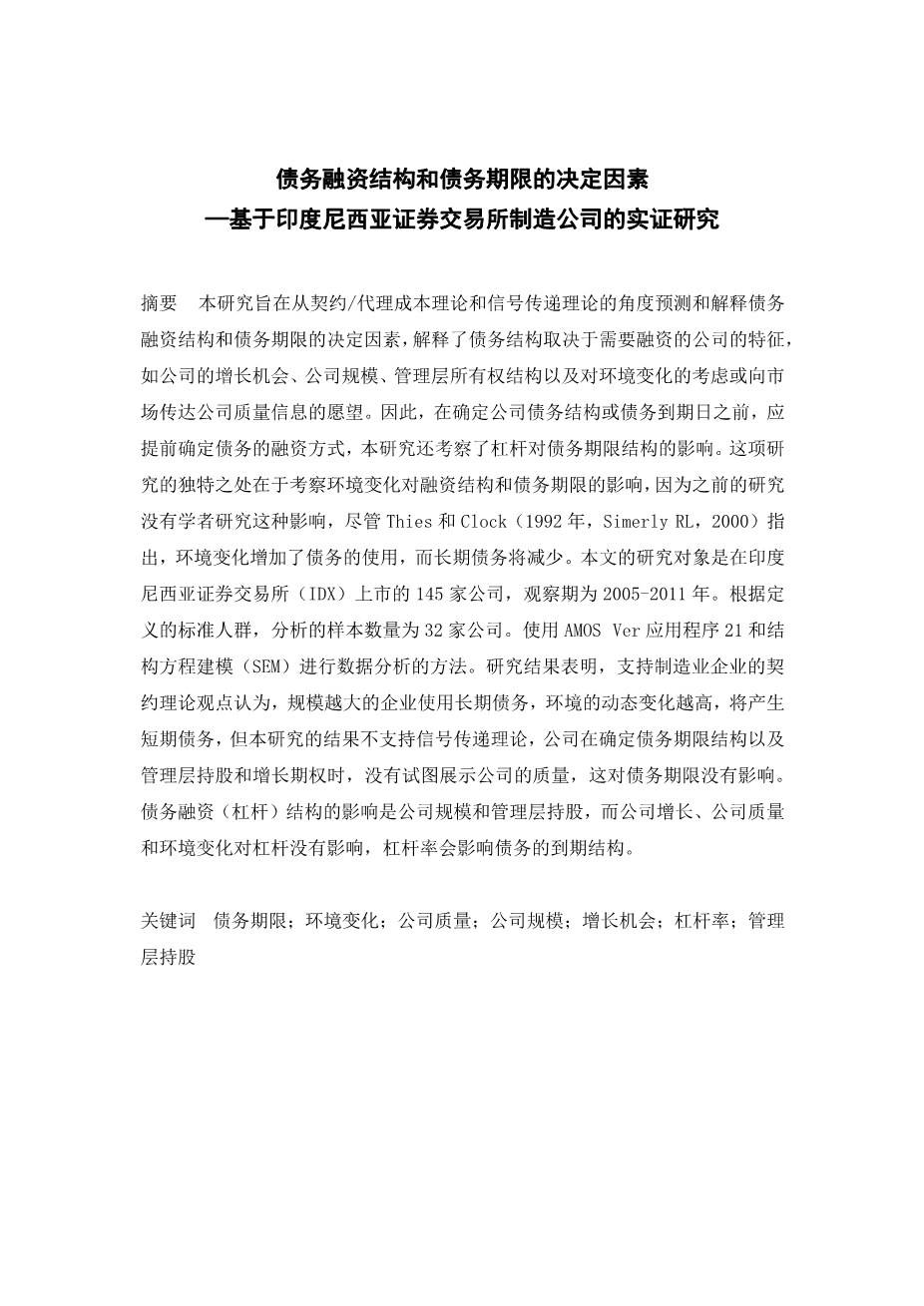Determinants of Debt Financing Structure and Debt Maturity - (Empirical Studies of Manufacturing Company on Indonesia Stock Exchange)
Abstract This study aims to predict and explain the determinants of debt financing structure and debt maturity from the perspective of contracting /agency cost theory and Signaling theory that explains that determines the structure of debt depends on the characteristics of companies that need funding as the companys growth opportunities, firm size , managerial ownership structure as well as the consideration of a change in environment or a desire to signal to the market about the quality of the company. Therefore, before determining the structure of corporate debt or debt maturity should be decided in advances that the financing of the debt taken, the study also examines the effect of leverage on the term structure of debt. The uniqueness of this study was to examine the effect of environmental change on the structure of funding and debt maturity, because previous research no one has studied the effect, although Thies and Clock (1992 in Simerly RL 2000) states that environmental changes increased the use of debt and long-term debt will decrease. The population of the research is the entire manufacturing companies listed in Indonesia Stock Exchange (IDX) of 145 companies with the observation period 2005-2011. Based on the criteria defined population, the number of samples analyzed was 32 companies. Methods of data analysis using Structural Equation Modeling (SEM) using AMOS Ver application program 21. The study findings suggest that contracting theoretical perspective that supports manufacturing companies that the larger companies use long-term debt, and the higher the dynamic changes in the environment will take a short-term debt, but the results of this study do not support the signaling theory, that the company is not trying to show the quality of the company in determining the maturity structure of the debt as well as managerial stock ownership and growth options has no effect on debt maturity. While the effect on the structure of the debt financing (leverage) is the size of the company and managerial stock ownership, while, corporate growth, corporate quality, and environmental changes found to have no effect on leverage. Leverage found to affect the maturity structure of the debt.
Keywords Debt maturity, Environmental changes, Firm quality, Firm size, Growth opportunities, Leverage, Managerial stock ownership
2. Hypotheses
Based on well understood relationships, the following hypotheses are proposed.
Effect of growth options, firm size, firm quality, managerial ownership and environmental changes on leverage
H1.1:Growth options provide negative effect on leverage
H1.2:Firm size provide positive effect on leverage
H1.3:Firm quality provide positive effect on leverage
H1.4:Managerial ownership structure provide negative effect on leverage
H1.5:Evironmental change provide negative effect on leverage
Effect of growth options, firm size, firm quality, managerial ownership and environmental changes on debt maturity.
H2.1:Growth options provide negative effect on debt maturity
H2.2:Firm size provide positive effect on debt maturity
H2.3:Firm quality provide positive effect on debt maturity
H2.4:Managerial ownership structure provide negative effect on debt maturity
H2.5:Evironmental change provide negative effect on debt maturity
Effect of leverage on debt maturity
H3:Leverage provide positive effect on debt maturity
3. Data dan Variables
3.2. Variables
3.2.1. Exogenous Variables
- Growth Options
Mesurement of growth options refers to Cai et al. [2]; Smith and Watts [10]; Barclay and Smith [11]; and Zheng et al. [12].
(1)
Market value of equity is total outstanding stock multiplied by closing price.
- Firm Size
Firm size used in this study is size of company that proxied with firm value that measured by number of shares outstanding multiplied by share price added by book value debt. This measure will give a better description about firm size as it is associated with companys stock price position in stock market [2, 11].
(3)
- Firm Quality
Mesurement of firm quality refers to Cai et al. [2]; Stohs and Mauer [13].
(4)
(5)
- Managerial Ownership
Managerial ownership is defined as percentage of equity owned by management. This study did not use category but include all of percentage numbers of managerial stock ownership.
(6)
- Environmental Changes
Measurement of environment changes in this research is use of sales growth variation achieved by company. This formula is refers to Thies and Klock cited in Simerly and Li [8].
(7)
3.2.2. Endogenous Variables
- Debt Maturity
Debt maturity is percentage of long-term debt on total debt. This formula is refers to Cai et al. [2]; Barclay and Smith [11]; and Antonio et al. [14].
(8)
Long-term debt is debt that has duration in more than one year.
- Leverage
This formula is refers to Stohs and Mauer [13]; Barclay and Smith [15].
(9)
Market value of company is total share outstanding multiplied by share price added by book value of debt.
4. Result
4.3. Discussion
4.3.1. Effect of Growth Options on the Leverage
Firm growth options are measured based on ratio of market value of asset on book value of asset. The higher of ratio resulting in higher of firm growth option viewed from intrinsic value. Growth options a
剩余内容已隐藏,支付完成后下载完整资料
英语译文共 12 页,剩余内容已隐藏,支付完成后下载完整资料
资料编号:[589255],资料为PDF文档或Word文档,PDF文档可免费转换为Word
课题毕业论文、外文翻译、任务书、文献综述、开题报告、程序设计、图纸设计等资料可联系客服协助查找。




